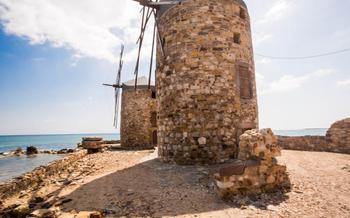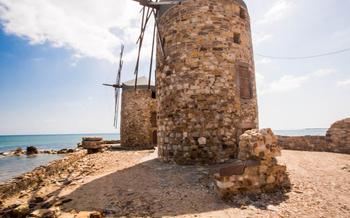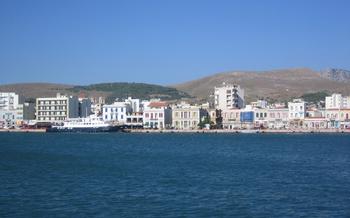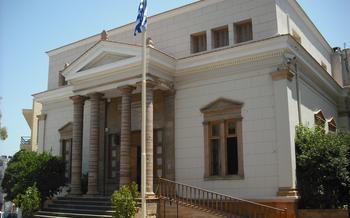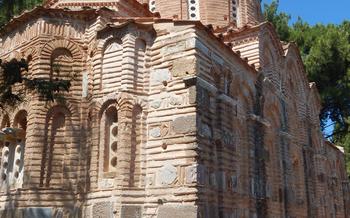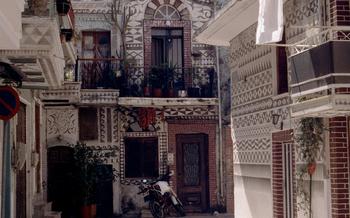
Mastic Museum of Chios
- The Antiquity of Chios Mastic
- Mastic Production Process
- Applications of Chios Mastic
- Mastic Villages of Chios
- Mastic Festivals and Events
- Mastic-Themed Souvenirs
- Mastic-Inspired Cuisine
- Sustainable Mastic Production
- Mastic and the Environment
- Mastic in Art and Literature: A Source of Inspiration
- Mastic and Religion
- Mastic and Health
- Mastic in Modern Life
- Insider Tip
The Antiquity of Chios Mastic
Mastic, a natural resin produced by the mastic tree (Pistacia lentiscus var. chia), has a rich and storied history in Chios, an island located in the Aegean Sea.
Since ancient times, Chios has been renowned for its mastic production, dating back to the 5th century BC. Theophrastus, a Greek philosopher and naturalist, described mastic as a valuable commodity used for its medicinal and culinary properties.
Chios' unique climate and geography, characterized by hot, dry summers and mild winters, create ideal conditions for the cultivation of mastic trees.
According to legend, the discovery of mastic is attributed to a shepherd boy who noticed that his goats' beards became sticky after grazing near mastic trees. Upon investigation, the boy found that the sticky substance was mastic resin, which he then shared with his fellow villagers, leading to the start of mastic cultivation in Chios.
Mastic Production Process
Mastic: A Natural Resin from the Mastic Tree
The production of Chios mastic is a centuries-old tradition that has been passed down from generation to generation. Mastic, a natural resin, is collected from the mastic tree, Pistacia lentiscus var. chia, which is native to the island of Chios. The trees are cultivated in specific areas of the island, known as mastic villages, where the unique climate and soil conditions create the ideal environment for their growth.
Traditional Cultivation and Harvesting Techniques
The cultivation of mastic trees requires patience and skill. The trees are typically planted in the fall or winter and take several years to mature. Once mature, the trees are tapped to collect the mastic resin. This process, known as "kentrimata," involves making small incisions in the bark of the tree with a special tool called a "kentri." The resin seeps out from the incisions and hardens into small, tear-shaped drops.
Demonstration of Mastic Tapping and Processing
Visitors to the Chios Mastic Museum can witness a live demonstration of the mastic tapping process. Skilled mastic farmers demonstrate the traditional techniques used to collect the resin, and visitors can learn about the different stages of mastic production, from tapping to sorting and cleaning.
The Skill and Dedication of Mastic Farmers
Mastic farming is a labor-intensive process that requires skill, dedication, and a deep understanding of the mastic tree. The farmers carefully tend to their trees throughout the year, pruning them, fertilizing them, and protecting them from pests and diseases. The tapping process itself requires patience and precision, as the incisions must be made at the right time and in the right way to ensure a good yield of mastic.
Applications of Chios Mastic
Mastic's Culinary and Medicinal Merits
The history of Chios mastic is intertwined with its diverse applications, both medicinal and culinary. Since ancient times, mastic has been revered for its healing properties, serving as a natural remedy for various ailments. Its antibacterial and anti-inflammatory qualities made it a sought-after ingredient in traditional medicine, particularly for treating digestive issues and wound healing.
In the culinary realm, mastic has earned a reputation as a unique flavoring agent, adding a subtle yet distinct aroma and taste to a variety of dishes. Its versatility extends from savory to sweet creations, with mastic commonly infused into liqueurs, pastries, and desserts. The island's signature liqueur, Mastiha, is a testament to the harmonious blend of mastic's flavor and the local spirit-making tradition.
Practical Applications: A Culinary Adventure
Visitors to Chios can embark on a culinary journey, savoring the flavors of mastic-infused delicacies. From the aromatic Mastiha liqueur to the tantalizing Mastic-flavored ice cream, each bite offers a taste of the island's unique heritage. Local restaurants showcase mastic's versatility, incorporating it into both traditional and contemporary dishes.
Anecdote: The Healing Power of Mastic
In a small village nestled among the mastic groves, an elderly woman named Maria shared her personal story of healing with mastic. Suffering from chronic stomach pain, she turned to traditional remedies and discovered the miraculous effects of mastic. Regular consumption of mastic tea not only alleviated her discomfort but also improved her overall well-being. To this day, Maria remains a firm believer in the healing power of Chios mastic.
Mastic Villages of Chios
History of the Villages Involved in Mastic Cultivation
The mastic villages of Chios hold a significant place in the island's history and culture, deeply intertwined with the cultivation and production of mastic. These villages have played a crucial role in preserving the traditional techniques and knowledge associated with mastic production, passed down through generations of skilled mastic farmers.
Notion of Mastic Villages as Centers of Mastic Production and Culture
These villages are not just centers of mastic production but also vibrant cultural hubs that showcase the unique heritage and traditions surrounding mastic. They offer visitors a glimpse into the lifestyle and customs of the mastic-producing communities, allowing them to experience the authentic essence of Chios's mastic culture.
Practical: List of Mastic Villages to Visit for a Deeper Insight
To immerse yourself in the world of mastic, be sure to visit these picturesque mastic villages:
- Pyrgi: A captivating village renowned for its unique architecture, featuring intricate stone carvings and narrow cobblestone streets.
- Mesta: A fortified medieval village with a charming maze-like layout, transporting visitors back in time.
- Olymbi: A scenic village nestled amidst lush greenery, offering breathtaking views of the surrounding countryside.
Anecdote: A Story About the Traditions and Lifestyle of Mastic Villagers
During my visit to Mesta, I had the privilege of meeting a local mastic farmer, Giorgos. He shared fascinating stories about his family's centuries-old involvement in mastic production. He explained how the villagers work together, sharing knowledge, tools, and techniques to ensure a successful harvest each year. Giorgos's passion and dedication to mastic cultivation were truly inspiring, highlighting the deep connection between the villagers and this precious resin.
Mastic Festivals and Events
Mastic festivals and events are a vibrant part of Chios culture, showcasing the island's unique mastic heritage and promoting local products.
The most prominent event is the annual Mastic Festival, held in August in the village of Pyrgi, the heart of mastic cultivation. This colorful festival is a celebration of the mastic harvest, with traditional music, dancing, and food stalls offering mastic-infused delicacies. Visitors can witness live demonstrations of mastic tapping and processing, and purchase authentic mastic products directly from local producers.
Another notable event is the Masticha Marathon, a unique sporting event that takes place in October. This challenging race winds through the picturesque mastic villages, offering participants the chance to immerse themselves in the island's mastic-scented landscape while enjoying the thrill of competition.
These festivals provide a wonderful opportunity to learn about mastic's history, traditions, and diverse applications. They also serve as a platform for local producers to showcase their products and connect with visitors from around the world.
Anecdote:
During the Mastic Festival, I had the pleasure of meeting an elderly woman who shared her memories of mastic harvesting in her youth. She described the excitement of climbing the trees and carefully collecting the precious resin, a task that required skill and patience. Her passion for mastic and her pride in her village's heritage were truly inspiring.
Mastic-Themed Souvenirs
Chios mastic has a long history as a popular souvenir from the island, treasured by visitors for its unique flavor and aroma. Over the centuries, mastic-based products have become synonymous with Chios, offering a taste of the island's rich culinary and cultural heritage.
Practical:
When searching for authentic mastic products, it's important to visit reputable shops and markets. The Chios Mastic Museum Shop is an excellent place to start, offering a wide range of high-quality mastic-infused products, including traditional sweets, liqueurs, cosmetics, and more. Other recommended spots include local farmers' markets, where you can find fresh mastic resin and homemade products directly from the producers.
Anecdote:
During my visit to Chios, I stumbled upon a charming little shop tucked away in a narrow alleyway. The shelves were lined with colorful jars filled with mastic-infused delights, from shimmering liqueurs to delicate sweets. As I browsed the selection, the shop owner, a friendly old lady named Maria, approached me with a warm smile. She enthusiastically shared stories about the history of mastic production on the island and recommended her favorite products. I couldn't resist purchasing a bottle of her homemade mastic liqueur, which I savored slowly, enjoying its rich, complex flavor. It was a delightful reminder of my time on Chios and a souvenir that I will cherish for years to come.
Mastic-Inspired Cuisine
Mastic has played a significant role in shaping the culinary traditions of Chios. For centuries, locals have incorporated this aromatic resin into their dishes, creating unique and flavorful creations.
Mastic's distinct flavor profile, a harmonious blend of sweetness, pungency, and piney notes, has made it a versatile ingredient in Chios cuisine. From savory main courses to sweet desserts, mastic adds a touch of complexity and depth to every dish.
Practical: Recipes or recommendations for mastic-infused dishes
One of the most iconic mastic-infused dishes is mastiha-flavored ice cream. This creamy dessert features a delicate balance of sweetness and mastic's characteristic flavor, making it a popular treat among locals and visitors alike.
For a savory experience, try the traditional mastic-marinated lamb. The lamb is slowly cooked in a marinade infused with mastic, resulting in a tender and flavorful dish that showcases the resin's ability to enhance the taste of meat.
For a sweet and aromatic treat, indulge in mastic-infused baklava. This classic Greek pastry is filled with layers of filo dough, chopped nuts, and honey, and flavored with mastic for an unforgettable taste sensation.
Anecdote: A story about a memorable mastic-flavored culinary experience
I vividly recall my first taste of mastic-infused cuisine during a visit to Chios. As I savored a spoonful of mastic ice cream, I was struck by the unique and captivating flavor that danced on my palate. The sweetness was perfectly balanced by the resin's subtle pungency, creating a harmonious and unforgettable taste experience.
Since then, I have made it a point to seek out mastic-infused dishes whenever I visit Chios. Whether it's a simple scoop of ice cream or an elaborate feast, mastic always adds a touch of magic to the culinary journey.
Sustainable Mastic Production
History of Preservation Efforts:
Chios's mastic farmers have a long history of sustainable practices, dating back to the Byzantine era. Recognizing the need to protect their valuable crop, they established strict regulations to ensure the responsible cultivation of mastic trees. These regulations included limits on the number of trees that could be tapped, the frequency of tapping, and the use of sustainable harvesting methods.
Notion of Preserving Mastic Trees:
In modern times, the preservation of mastic trees has become even more critical due to increasing environmental concerns. Mastic trees are a vital part of the island's ecosystem, providing habitat for local wildlife and contributing to the overall biodiversity of the region. Sustainable farming practices are essential to protect these trees and ensure the continuation of mastic production for generations to come.
Practical Initiatives for Sustainability:
To promote sustainable mastic production, several initiatives have been implemented. The Chios Mastic Growers Association plays a crucial role in educating farmers about sustainable practices, providing technical assistance, and promoting environmentally friendly cultivation methods. Additionally, the Greek government has established regulations to protect mastic trees and ensure compliance with sustainable harvesting practices.
Anecdote: A Farmer's Commitment:
Giorgos, a third-generation mastic farmer, is a passionate advocate for sustainable production. He has adopted innovative techniques to minimize his environmental impact, such as using solar-powered irrigation systems and natural fertilizers. Giorgos believes that by embracing sustainable practices, he is not only ensuring the future of his family's livelihood but also contributing to the preservation of Chios's unique natural heritage.
Mastic and the Environment
Mastic trees have long been an integral part of Chios' natural ecosystem, playing a crucial role in maintaining biodiversity and environmental balance. Their deep roots help to prevent soil erosion, protecting the island's fragile landscape from the effects of heavy rains and strong winds. Additionally, mastic trees provide a habitat for a variety of animal species, including birds, insects, and reptiles, contributing to the overall richness of the island's fauna.
Practical: Examples of How Mastic Trees Contribute to the Island's Environment
- Mastic trees help to regulate the island's water cycle by absorbing and storing rainwater, releasing it slowly into the soil and preventing flooding.
- Mastic trees contribute to air purification by releasing oxygen and absorbing pollutants, improving the island's air quality.
- Mastic trees provide shade and shelter for livestock, protecting them from the sun and rain.
Anecdote: A Story About the Role of Mastic Trees in Protecting Local Wildlife
In a small village on the island of Chios, a local farmer named Yannis noticed that the bird population in his orchard had been declining in recent years. Determined to find a solution, he consulted with a local environmentalist who suggested planting mastic trees around the orchard. Yannis followed the advice, and within a few years, the bird population had returned and even increased, drawn to the shelter and food provided by the mastic trees.
Mastic in Art and Literature: A Source of Inspiration
Mastic's unique qualities have captivated the imaginations of artists and writers throughout history. Its rich aroma, golden color, and versatility as a medium have made it a popular subject in various forms of art.
In the realm of painting, mastic has been used as a glazing agent, adding depth and luminosity to works by renowned artists such as El Greco and Caravaggio. Its ability to enhance the brilliance of colors has made it a valuable tool for creating vibrant and lifelike masterpieces.
Literature, too, has embraced mastic as a source of inspiration. Ancient Greek poets like Homer and Theophrastus extolled its virtues in their writings, while later authors such as Dante and Chaucer mentioned it in their works. In more recent times, mastic has been featured in novels, short stories, and poems by contemporary Greek and international writers.
One notable example is the novel "The Mastic Tree" by Greek author Michalis Karapanos. This historical fiction delves into the lives of mastic cultivators on the island of Chios, capturing the essence of their unique culture and the significance of mastic in their daily lives.
Mastic's versatility extends beyond traditional art forms. In contemporary times, it has found its way into modern art installations, sculptures, and even fashion design. Its unique texture and color have made it a popular choice for creating visually striking and thought-provoking works of art.
Whether in the hands of ancient masters or modern-day creatives, mastic continues to inspire and captivate, serving as a testament to its timeless beauty and cultural significance.
Mastic and Religion
Mastic has held a significant place in religious traditions and rituals throughout history, particularly in the Greek Orthodox Church. Its unique properties and aroma have made it a symbol of purity and devotion. During religious ceremonies, mastic is often burned as incense, filling the air with its fragrant smoke. It is believed that the sweet aroma purifies the atmosphere and creates a sacred ambiance. Additionally, mastic oil is sometimes used in the preparation of holy water and anointing oils, symbolizing spiritual cleansing and renewal. In some regions, mastic is even incorporated into traditional religious garments and vestments, representing the connection between the divine and the earthly realms.
Mastic and Health
Mastic, a natural resin from the mastic tree, has been prized for its medicinal properties since ancient times. Theophrastus, a Greek philosopher and naturalist, wrote about mastic's healing powers in the 3rd century BC, and Hippocrates, the father of medicine, recommended it for treating digestive problems.
In traditional medicine, mastic has been used to treat a wide range of ailments, including stomach ulcers, diarrhea, dysentery, and sore throats. It is also believed to have antimicrobial, antioxidant, and anti-inflammatory properties.
Modern scientific studies have supported some of the traditional claims about mastic's health benefits. For example, one study found that mastic can help to reduce the severity of stomach ulcers, and another study found that it can help to improve gum health.
Mastic is also being investigated for its potential to treat other conditions, such as cancer and heart disease. While more research is needed to confirm these potential benefits, mastic is a promising natural remedy with a long history of use in traditional medicine.
Anecdote:
My grandmother always swore by the healing powers of mastic. When I was a child, she would give me a piece of mastic to chew whenever I had a stomachache or a sore throat. I always felt better after chewing mastic, and I believe that it helped me to get over my illnesses more quickly.
Mastic in Modern Life
Mastic has come a long way from its humble origins as a natural resin. Today, it's a versatile ingredient used in a wide range of industries, from food and beverage to cosmetics and pharmaceuticals. Here are just a few examples of modern-day products incorporating mastic:
-
Food and Beverage: Mastic is used as a flavoring agent in a variety of food and beverage products, including chewing gum, ice cream, candy, and beverages like liqueurs and soft drinks.
-
Cosmetics: Mastic is a popular ingredient in skincare and hair care products due to its anti-aging and moisturizing properties. It is also used in perfumes and soaps for its unique aroma.
-
Pharmaceuticals: Mastic has been used in traditional medicine for centuries, and modern research has confirmed its effectiveness in treating a variety of health conditions, including ulcers, gastritis, and inflammation. It is now used as an ingredient in various pharmaceutical products.
-
Industrial Applications: Mastic is also used in a variety of industrial applications, such as varnishes, paints, and adhesives.
One recent innovation in the use of mastic is its application in the production of bioplastics. Researchers have developed a new type of bioplastic made from mastic resin, which is biodegradable and environmentally friendly. This breakthrough could potentially revolutionize the plastics industry and reduce the environmental impact of plastic pollution.
Insider Tip
For an unparalleled mastic experience, plan your visit to coincide with the annual Mastic Festival, usually held in September. Immerse yourself in the vibrant atmosphere as the island celebrates its iconic product. Witness traditional mastic tapping demonstrations, savor delicious mastic-infused delicacies, and shop for unique mastic-based souvenirs. Don't miss the chance to engage with local mastic farmers and learn firsthand about their passion and expertise.


